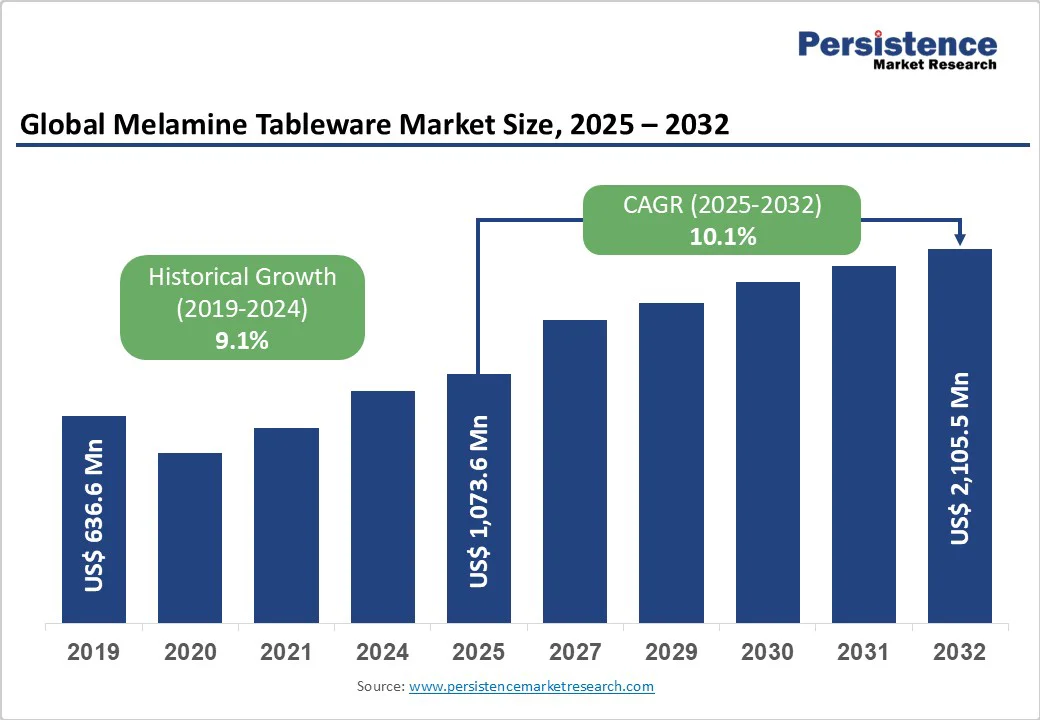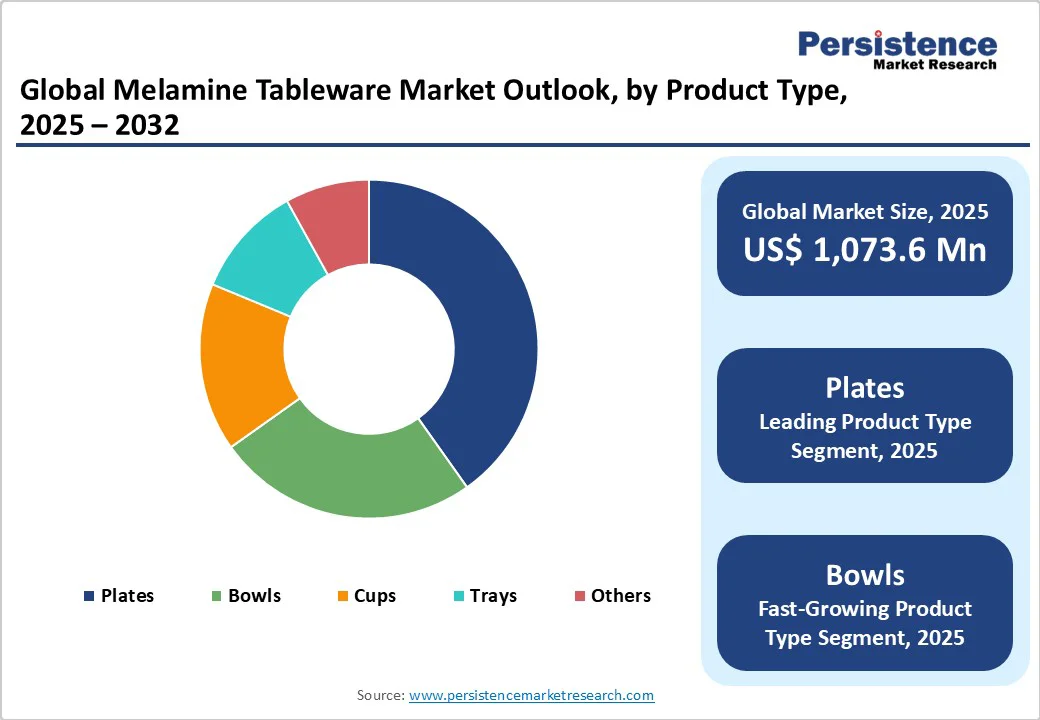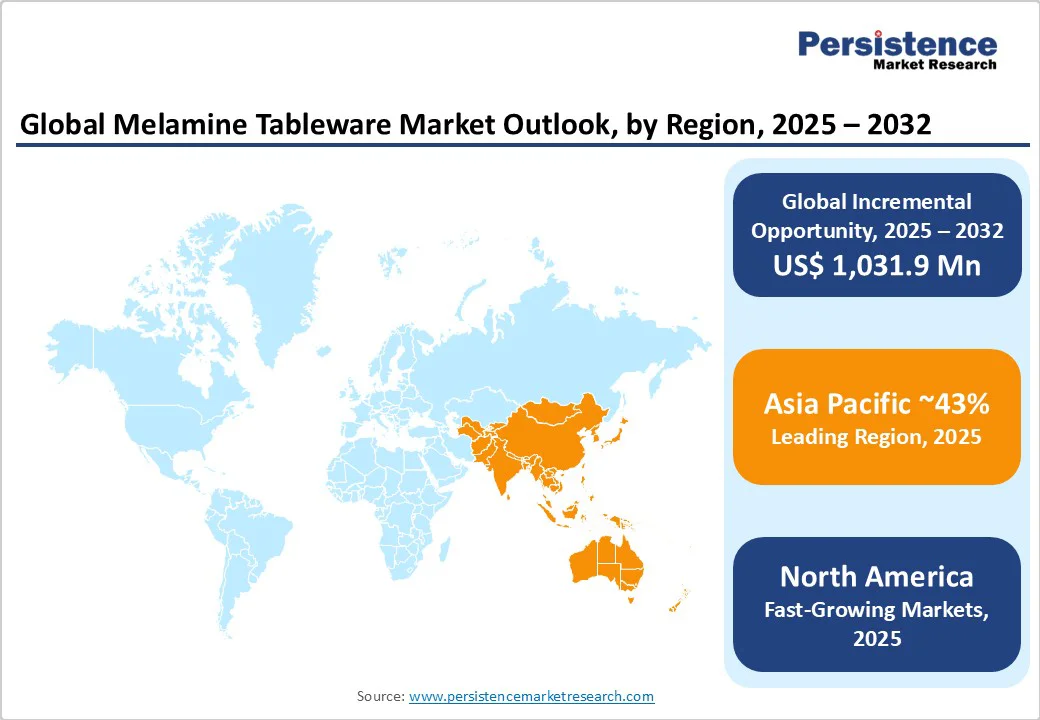ID: PMRREP35778| 193 Pages | 27 Oct 2025 | Format: PDF, Excel, PPT* | Chemicals and Materials

The global melamine tableware market size is likely to be valued at US$ 1,073.6 million in 2025, and is projected to reach US$ 2,105.5 million by 2032, growing at a CAGR of 10.1% during the forecast period 2025 - 2032. Market growth is driven by rising consumer demand for durable, lightweight, and shatter-resistant tableware across residential and commercial sectors.
Increased adoption in the hospitality industry, coupled with the growing trend of outdoor dining and cost advantages over ceramic alternatives, supports robust demand. The shift toward casual lifestyle dining and multifunctional tableware is expected to further elevate market prospects and enhance stakeholder performance and innovation.
| Key Insights | Details |
|---|---|
| Melamine Tableware Market Size (2025E) | US$ 1,073.6 Mn |
| Market Value Forecast (2032F) | US$ 2,105.5 Mn |
| Projected Growth CAGR (2025 - 2032) | 10.1% |
| Historical Market Growth (2019-2024) | 9.1% |

The hospitality and foodservice sector are a major catalyst for the melamine tableware market. Restaurants, hotels, and catering services are increasingly opting for melamine products due to their durability, break-resistance, and cost efficiency compared with traditional ceramic or glass alternatives.
In commercial environments, the lightweight nature of melamine reduces staff fatigue during handling and lowers replacement costs. Additionally, the attractive aesthetics of melamine tableware, which mimic traditional materials, make it suitable for upscale dining.
Melamine tableware also enjoys wide popularity among urban households, with surveys showing 65% of city dwellers prefer melamine over ceramics due to its shatterproof properties and vibrant designs. The products’ resistance to temperature and weather variations makes them ideal for patios, poolside areas, and camping activities.
Higher disposable incomes in emerging economies are fueling the demand for stylish, affordable, and multifunctional tableware that complements casual dining and modern lifestyles. As consumers prioritize convenience, safety, and aesthetics in everyday dining, melamine continues to gain traction across domestic, outdoor, and recreational use, further supporting overall market growth.
Strict regulations, particularly from the U.S. Food and Drug Administration (FDA), limit melamine content in tableware due to concerns about migration into foods, especially acidic or high-temperature dishes. Excessive exposure to melamine has been linked to potential kidney health risks, prompting authorities to enforce stringent safety standards.
Manufacturers must comply with these regulations through rigorous quality control, testing, and certification processes, which increase operational costs and production complexity. Ensuring adherence to safety guidelines is critical to market access, particularly in North America and Europe, where regulatory scrutiny is high. These compliance requirements act as a restraint on small-scale manufacturers and new market entrants.
The melamine tableware market growth also faces increasing pressure from environmentally conscious consumers, challenging reliance on petroleum-based melamine production. Fluctuations in crude oil prices directly affect manufacturing costs and retail pricing, creating operational and strategic challenges.
Furthermore, growing consumer preference for eco-friendly and sustainable alternatives has prompted manufacturers to explore bio-composites, bamboo-filled resins, and other environmentally friendly innovations. While this shift promotes long-term sustainability, it also requires significant R&D investment and production adjustments, which may slow adoption and constrain short-term growth in regions where traditional melamine dominates.
Advanced manufacturing techniques have enabled the production of ultra-high-heat-resistant melamine, making products suitable for microwave and oven-safe applications. This expansion in functionality opens up new segments in both residential and commercial markets.
The integration of AI-driven quality control has improved production efficiency, reducing defect rates considerably. Innovations such as self-healing surfaces extend product lifecycles, enhance durability, and allow brands to differentiate through premium product lines. These developments create opportunities for higher-margin offerings and stimulate consumer interest in versatile, long-lasting, and aesthetically appealing melamine tableware.
A key market for melamine tableware is Asia Pacific, led by China, which controls around 38% of the market due to high production capacity, labor availability, and strong domestic consumption. On the other hand, India’s expanding middle class is fueling the demand for attractive and affordable dinnerware, driving higher home improvement spending and contributing to the estimated 12.3% CAGR of the regional market, well above the global average.
Combined with local manufacturing advantages, cost efficiencies, and strong export potential, Asia Pacific offers significant growth opportunities, both for established players and new entrants seeking to capture expanding residential and commercial demand.
Plates are expected to dominate the melamine tableware market, accounting for approximately 45% of the revenue share in 2025, as a result of their widespread use in residential and commercial settings. Their durability, resistance to chipping and staining, and broad design range make them ideal for both household dining and professional foodservice applications.
Melamine plates also enhance food presentation with attractive designs, appealing to restaurants, hotels, and catering services. In commercial environments, the thermal shock resistance of melamine plates reduces replacement frequency and operational costs, making them a cost-effective, long-lasting, and versatile choice across multiple market segments.
The commercial segment is estimated to represent around 60% of the market in 2025, driven by the extensive use of melamine tableware in restaurants, hotels, schools, and healthcare facilities, where frequent breakage and replacement have created a strong demand for durable tableware.
Post-pandemic recovery and the resurgence of dining out have further boosted investment in long-lasting, high-quality melamine products. Institutions also prioritize safety, hygiene, and ease of cleaning, making melamine tableware an attractive choice for high-traffic settings. The ability of the material to combine functionality, durability, and aesthetic appeal continues to support its growth in commercial applications across the globe.

North America is a leading market for melamine tableware, supported by high consumer spending, robust supply chains, and strong commercial demand. The U.S. restaurant sector alone is projected to grow 3.3% annually between 2023 and 2028, reflecting sustained demand for durable and stylish tableware.
Consumers increasingly prefer long-lasting products for casual and everyday dining, while commercial establishments value melamine for its lightweight and break-resistant properties. Besides this, strict regulatory frameworks, particularly the FDA’s migration guidelines, push continuous product innovation focused on enhanced safety, quality, and sustainability, encouraging manufacturers to develop advanced, compliant tableware solutions.
Europe is anticipated to account for approximately 18% of the melamine tableware market share in 2025, with Germany as both a leading producer and consumer. The U.K. and France contribute significantly to regional growth, fueled by rising hospitality demand and increasing trends in outdoor and casual dining.
Harmonized safety standards across the European Union (EU) have facilitated cross-border sales, while European consumers show strong preference for eco-friendly, innovative, and premium-quality products. Manufacturers in the region emphasize sustainability, advanced designs, and compliance with health regulations to cater to consumer expectations, reinforcing Europe’s stable yet innovation-driven market trajectory.
Asia Pacific is the fastest-growing and largest-volume regional market for melamine tableware, with China dominating both production and consumption due to efficient supply chains, low labor costs, and access to raw materials. India, set to exhibit an approximate 12.3% CAGR through 2032, is emerging as a key market driven by rising disposable incomes and evolving dining culture.
Japan contributes through established foodservice channels and a strong focus on product quality. Combined, these countries make Asia Pacific the powerhouse of the melamine tableware market, offering opportunities for domestic sales, exports, and innovation-driven growth across both commercial and residential segments.

The global melamine tableware market structure is moderately consolidated, featuring a mix of large multinational manufacturers and regional specialists. Competition primarily revolves around product durability, aesthetics, safety, and production efficiency, with companies striving to differentiate through quality and innovation.
Market players are focusing on research and development, adopting advanced manufacturing techniques and sustainable practices to meet evolving consumer preferences and comply with stringent regulatory standards. Strategic investments in design, operational efficiency, and premium product offerings help maintain competitive advantages, enhance brand loyalty, and support expansion across residential, commercial, and institutional segments.
The global melamine tableware market is projected to reach US$ 1,073.6 million in 2025.
Key market drivers are hospitality sector adoption, outdoor dining trends, exceptional durability, and cost efficiency for commercial clients.
The market is poised to witness a CAGR of 10.1% from 2025 to 2032.
Technological advances in heat resistance, AI-driven quality control, and expanding markets in Asia Pacific underpin future growth.
Some of the key market players include GET Enterprises, Carlisle Foodservice Products, Elite Global Solutions, American Metalcraft, and Kip Melamine.
| Report Attribute | Details |
|---|---|
| Historical Data/Actuals | 2019 - 2024 |
| Forecast Period | 2025 - 2032 |
| Market Analysis | Value: US$ Mn/Bn, Volume: As Applicable |
| Geographical Coverage |
|
| Segmental Coverage |
|
| Competitive Analysis |
|
| Report Highlights |
|
By Product Type
By Application
By Region
Delivery Timelines
For more information on this report and its delivery timelines please get in touch with our sales team.
About Author